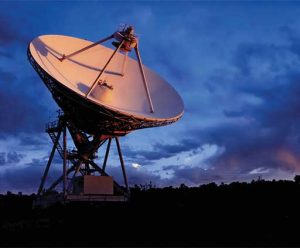A team of radio astronomers has used the National Science Foundation’s Very Long Baseline Array (VLBA) to make the most accurate measurement ever made of the distance to a faraway galaxy.
Continent-spanning Telescope Blazes Trails
The supersharp radio vision of the National Science Foundation’s Very Long Baseline Array is revealing unprecedented details of astronomical objects from stars in our own cosmic neighborhood to galaxies billions of light-years away.
Axis of Universe Not Seen in Data, Astronomers Say
A claim that the universe has a preferred direction is not supported by recent observational evidence, according to three astronomers who analyzed data from the Very Large Array radio telescope in New Mexico and the WM Keck Telescope in Hawaii.
Mystery of Water Masers in NGC 1052
New observations with the National Science Foundation’s Very Long Baseline Array radio telescope have deepened the mystery surrounding water molecules in a galaxy 65 million light- years away.







